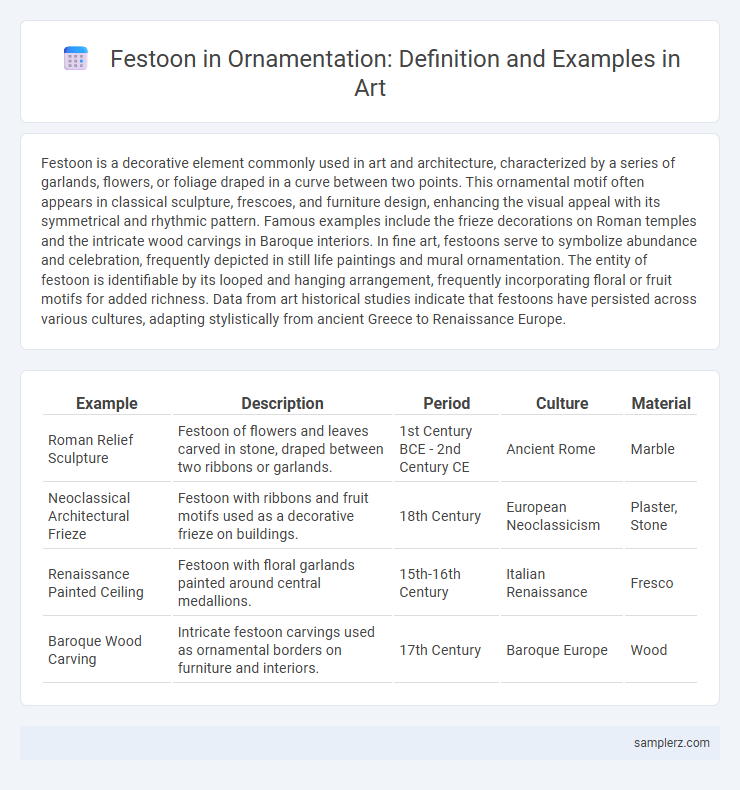Festoon is a decorative element commonly used in art and architecture, characterized by a series of garlands, flowers, or foliage draped in a curve between two points. This ornamental motif often appears in classical sculpture, frescoes, and furniture design, enhancing the visual appeal with its symmetrical and rhythmic pattern. Famous examples include the frieze decorations on Roman temples and the intricate wood carvings in Baroque interiors. In fine art, festoons serve to symbolize abundance and celebration, frequently depicted in still life paintings and mural ornamentation. The entity of festoon is identifiable by its looped and hanging arrangement, frequently incorporating floral or fruit motifs for added richness. Data from art historical studies indicate that festoons have persisted across various cultures, adapting stylistically from ancient Greece to Renaissance Europe.
Table of Comparison
| Example | Description | Period | Culture | Material |
|---|---|---|---|---|
| Roman Relief Sculpture | Festoon of flowers and leaves carved in stone, draped between two ribbons or garlands. | 1st Century BCE - 2nd Century CE | Ancient Rome | Marble |
| Neoclassical Architectural Frieze | Festoon with ribbons and fruit motifs used as a decorative frieze on buildings. | 18th Century | European Neoclassicism | Plaster, Stone |
| Renaissance Painted Ceiling | Festoon with floral garlands painted around central medallions. | 15th-16th Century | Italian Renaissance | Fresco |
| Baroque Wood Carving | Intricate festoon carvings used as ornamental borders on furniture and interiors. | 17th Century | Baroque Europe | Wood |
Defining Festoon: Origins and Meaning in Ornamentation
Festoon, originating from classical Greek and Roman art, is a decorative motif characterized by a garland of flowers, leaves, or ribbons draped in a curve between two points. This ornamental design symbolizes abundance and festivity, commonly found in architectural friezes, furniture carvings, and jewelry. Its intricate detailing enhances visual appeal and conveys celebratory or ceremonial significance in various art forms.
Historical Evolution of Festoon Motifs in Art
Festoon motifs in art trace their origins to ancient Greek and Roman architecture, where they adorned friezes and cornices with intricate garlands of flowers and leaves. During the Renaissance, these ornamental designs evolved to embody greater naturalism and complexity, frequently featuring ribbons and fruits in sculptural and painted decorations. In Neoclassical art, festoons became emblematic of refined elegance, symbolizing victory and abundance through symmetrical arrangements on furniture, ceramics, and interior moldings.
Festoon Designs in Classical Architecture
Festoon designs in classical architecture prominently feature garlands of flowers, leaves, and fruits draped between two points, symbolizing abundance and celebration. These ornamental motifs often appear carved in marble on friezes, cornices, and architraves of ancient Greek and Roman temples, exemplified by the Parthenon's intricate stone festoons. The use of festoon designs enhances the visual rhythm and elegance, reflecting the harmony and balance central to classical architectural aesthetics.
Festoon Ornamentation in Renaissance Decorative Arts
Festoon ornamentation in Renaissance decorative arts prominently features garlands of flowers and leaves draped in symmetrical swags, often accentuating architectural elements such as friezes and cornices. This motif draws inspiration from classical antiquity, reflecting Renaissance artists' fascination with nature and antiquarian revival, as seen in works by artists like Andrea Mantegna and in decorative stuccoes of Italian palazzi. The intricate festoons serve both aesthetic and symbolic functions, embodying themes of abundance and festivity central to the period's artistic vocabulary.
Baroque and Rococo Interpretations of Festoon
Baroque interpretations of festoon ornamentation often feature dramatic, symmetrical swags of flowers, leaves, and fruits that create a sense of grandeur and movement, prominently displayed in architecture and decorative arts. Rococo adaptations soften these forms with asymmetrical curves, lighter colors, and intricate detailing, emphasizing playful elegance and lightness. Notable examples include the Palace of Versailles' extravagant festoons in Baroque style and the delicate, ornate interiors of French Rococo salons.
Festoon Patterns in Furniture and Interior Design
Festoon patterns in furniture and interior design often feature garlands of flowers, leaves, or ribbons draped in a swag-like arrangement, adding classical elegance to spaces. These ornamental motifs appear prominently in neoclassical and rococo styles, where carved wooden chairs, mirrors, and cabinetry showcase intricate festoon detailing. The repetition of festoon elements creates rhythmic visual interest, enhancing both the aesthetic appeal and architectural harmony of interiors.
Festoon Elements in Sculpture and Relief Work
Festoon elements in sculpture and relief work frequently depict draped garlands of flowers, leaves, or fruit, enhancing architectural friezes and classical monuments with rhythmic, naturalistic ornamentation. These decorative motifs often symbolize abundance and celebration, prominently visible in ancient Roman and Renaissance art where they frame doors, windows, and altars. The intricate carving of festoons in marble or bronze highlights artisans' skill in creating dynamic, flowing compositions that complement the structural design.
Popular Materials Used for Creating Festoons
Festoons in ornamentation are commonly crafted from materials such as carved wood, plaster, and stone, each offering durability and intricate detailing. Bronze and wrought iron are also popular for creating outdoor festoons due to their resistance to weathering. In textile arts, silk and velvet are favored for soft festoon designs, adding a luxurious touch to interior decorations.
Symbolism Behind the Festoon in Artistic Traditions
Festoon ornamentation, often depicted as a garland of flowers, leaves, or ribbons, symbolizes abundance, celebration, and unity in many artistic traditions. In classical art, festoons evoke fertility and prosperity, reflecting the cycles of nature and seasonal renewal. This motif also appears in religious and ceremonial contexts, where it signifies honor, divine blessings, and communal harmony.
Contemporary Uses of Festoon in Modern Ornamentation
Contemporary uses of festoon in modern ornamentation often appear in architectural facades, interior design, and digital art installations, emphasizing fluidity and organic shapes. Designers incorporate festoons as repetitive decorative motifs in materials like metal, glass, and textiles to create dynamic visual rhythms. This modern adaptation maintains the classical festoon's essence while innovating through minimalist and abstract aesthetics.

example of festoon in ornamentation Infographic
 samplerz.com
samplerz.com